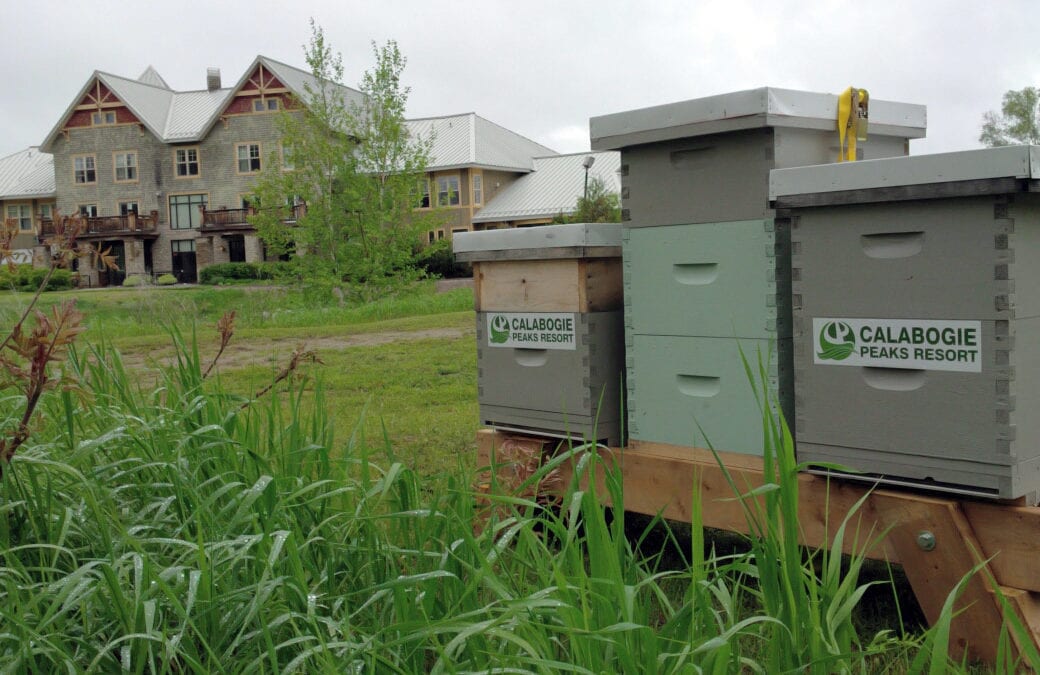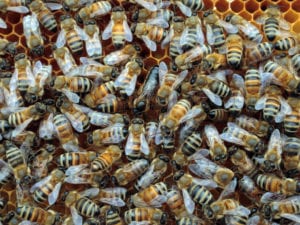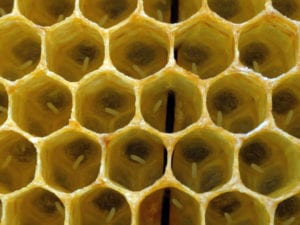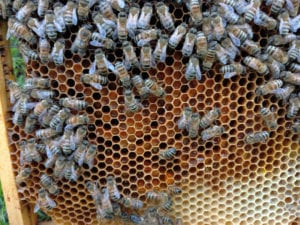
As part of our mission to bring local foods to Canthooks Restaurant, we have a new addition to the resort: bees! Thanks to Valley Beekeeping Supplies, we now have a thriving hard at work making honey for use in our scrumptious menu items. Amazing bees inspired Canthooks Restaurant Menu. For your convenience, here is a copy of the post from Valley Beekeeping’s blog.
On a foggy misty morning of Friday May 26/17, the queens and their workers have arrived at Calabogie Peaks Resort to make a new home. The hives will be placed across the pond from the restaurant where they can be viewed from the windows.
The arrival of the bees will be a welcomed addition to this fine resort providing pollination for the many native and planted plants around the resort. And in return the plants provide the bees with pollen and nectar. In the near future when there has been enough honey collected by the bees in the hives, the resort intends to use the freshly harvested honey as an added addition to their restaurant kitchen in all their cooking, baking, beverages, and anywhere else they can sweeten things up. The honey will also be available to the patrons of the restaurant for an added mix to your meals. You will also be able to find the honey available at the front desk for customers wishing to take some of the peaks sweetness home with you. All the honey collected for bottling is pure raw unpastuerized goodness to keep all the great benefits honey has to offer. The honey may contain fine particles of wax and pollen to add to the benefits of healthy eating.
For those of you who haven’t seen the inside of a working bee hive, we have added several pictures to show you a little of what’s happening inside where you can’t see the mysteries of the bee hive. In the picture to the right, you will find 2 boxes which currently are being used by the colony to raise new bees. At a later time when the colony has grown, we will be adding honey supers on top with a queen excluder in between the 2nd and 3rd box to keep the queen in the lower 2 boxes to lay eggs, and to collect clean nectar which the bees convert to honey over time in the upper boxes. The lighter boxes in the center of the 2 beehives are the honey boxes to be added in a couple weeks.
 In the picture to the left, you can see the young queen among the many nurse and worker bees. The queens generally can live up to 5-7 years, and their peak laying happens in their 2nd year where see can lay up to 1600 eggs a day. As for the other bees, they are for the most part all female. They emerge from their cells at birth and first take on the nurse bee role where they tend to the new eggs and larva as well as groom and feed the queen. In a week or two, the role changes to worker bee where they take the nectar and pollen and place it in the hive where it’s needed most. At nearly the 3rd week, the bees then leaves the hive to become a forager and flies around to collect nectar and pollen and return it to the hive where they meet the worker bees at the entrance and pass their haul over so that the worker can take it to it’s proper spot, and the forager can fly off for another load. At the time of being a forager, the bees work themselves literally to death. During the spring, summer and fall, honey bees only live 28 days.
In the picture to the left, you can see the young queen among the many nurse and worker bees. The queens generally can live up to 5-7 years, and their peak laying happens in their 2nd year where see can lay up to 1600 eggs a day. As for the other bees, they are for the most part all female. They emerge from their cells at birth and first take on the nurse bee role where they tend to the new eggs and larva as well as groom and feed the queen. In a week or two, the role changes to worker bee where they take the nectar and pollen and place it in the hive where it’s needed most. At nearly the 3rd week, the bees then leaves the hive to become a forager and flies around to collect nectar and pollen and return it to the hive where they meet the worker bees at the entrance and pass their haul over so that the worker can take it to it’s proper spot, and the forager can fly off for another load. At the time of being a forager, the bees work themselves literally to death. During the spring, summer and fall, honey bees only live 28 days.
 In the next picture to the right, this is a close up shot of actual wax comb from inside the hive where you can see the perfection of the wax comb made by the bees. You can also spot 1-2 day old eggs laid recently be the queen. In 21 days, these eggs will become new bees.
In the next picture to the right, this is a close up shot of actual wax comb from inside the hive where you can see the perfection of the wax comb made by the bees. You can also spot 1-2 day old eggs laid recently be the queen. In 21 days, these eggs will become new bees.
 In the final picture to the left, you can see more worker bees. You may also see new young bees eating pollen which provides them with needed protein at their young stage. In the majority of the picture you can see older wax comb, but in the bottom right corner you can see nice new white recently drawn wax comb. The wax generally darkens as the bees walk over it with their dirty little feet. In many of the cells, you can see a variety of different colored pollen collected from different floral sources. Some cells you can see a shiney fluid which is newly collected nectar. The bees will move and process the nectar up to 50 times to reduce the moisture to about 17-18% at which time it is now honey, and they will place a wax capping over each cell of honey once they are happy with the moisture content.
In the final picture to the left, you can see more worker bees. You may also see new young bees eating pollen which provides them with needed protein at their young stage. In the majority of the picture you can see older wax comb, but in the bottom right corner you can see nice new white recently drawn wax comb. The wax generally darkens as the bees walk over it with their dirty little feet. In many of the cells, you can see a variety of different colored pollen collected from different floral sources. Some cells you can see a shiney fluid which is newly collected nectar. The bees will move and process the nectar up to 50 times to reduce the moisture to about 17-18% at which time it is now honey, and they will place a wax capping over each cell of honey once they are happy with the moisture content.
You can read the full post on the Valley Beekeeping Supplies website.



